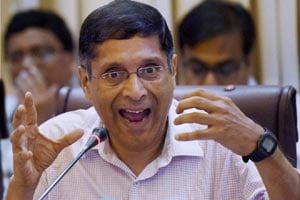The economy appeared to be in deflation territory or close to it, chief economic advisor (CEA) Arvind Subramanian said on Wednesday, even as he said that the 7% real GDP growth reported for the first quarter could be an underestimate. Pointing out that the prices, as measured by deflators for the gross value added (GVA), and GDP grew at just 0.1% and 1.7%, respectively, according to the latest Central Statistics Office’s estimates, he said even this GDP deflator estimate could be over-stated.
Subramanian’s argument appeared to buttress the case for interest rates cut by the Reserve Bank of India. According to him, the real challenge that loomed ahead appeared not to be price inflation but possibly price deflation. Both retail inflation and wholesale inflation hit record lows of 3.78% and -4.05%, respectively, in July.
The CEA noted that GVA, which was seen to expand 7.1% compared with 6.1% in the previous quarter, better reflected the economy’s recovery than the headline GDP number about which he advocated “utmost caution.”
He argued that the CSO’s procedure that assumes that indirect taxes grow in line with the relevant tax base (which consists of value of imports, manufacturing and services, all of which loosely correspond to volumes in the current situation), could be far from efficient in capturing the net indirect tax (NIT) increase during “unusual times” like the current one, when the indirect taxes are rising sharply. “If what I expect to happen with annual estimate (materialises) and the revenues maintain this pace, it is quite likely that the GDP number will be substantially higher than what has suggested by the latest number,” the CEA said.
Notwithstanding the lower-than-expected GDP growth estimated for the first quarter, the economy might clock close to 8% growth in FY16, he maintained, adding that his confidence stemmed from a “combination of oil price decreases, macro-economic stability, reforms, (lower) inflation and (moderation of) interest rates”. In the latest Economic Survey, the GDP growth was projected to be 8-8.5% in FY16, the RBI in the latest annual report retained its 7.6% growth estimate, while rating agency Moody’s lately put the figure at around 7%.
Under the new internationally compliant CSO methodology, indirect taxes are assumed to grow in line with the relevant tax base and in the case of subsidies, the CSO uses the GDP deflator to arrive at constant price estimates.
The CEA’s point is that since net indirect taxes (indirect taxes less subsidies) increased 40% in nominal terms in Q1FY6, the GDP estimate will have to be treated with caution, because of the commensurate potential for understating growth.

